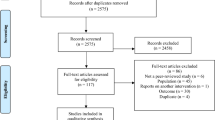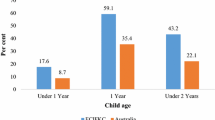Abstract
Visitation, assumed to be important for children in foster care, has not been studied in sufficent detail. In the present study, patterns and characteristics of home and foster family visitation and telephone contact are described in a national sample of children in foster care in Israel (n=590). Relations between child, biological and foster family characteristics are explored by type of contact and foster placement. Parent-child contact is most strongly related to foster family characteristics and relations with the biological family. Patterns differ for relative and nonrelative foster families.
Similar content being viewed by others
References
Ben-Rabi, D. (1990) Children in Israel — Family background. Masters Thesis. School of Social Work, Hebrew University.
Benbenishty, R. & Oyserman, D. (1990). Assessment of foster families. Hebrew University of Jerusalem.
Benbenishty, R., & Oyserman, D. (1991). A clinical information system for foster care in Israel.Child Welfare, LXX(2), 229–242.
Benbenishty, R., Oyserman, D., & Ben-Rabi, D. (1990). The clinical situation of children in foster care in Israel: Findings from the clinical monitoring system. Hebrew University of Jerusalem, Israel.
Cautley, P. W. (1980).New foster parents. New York: Human Sciences Press.
Dando, I. & Minty, B. (1987). What makes good foster parents.British Journal of Social Work, 17, 383–400.
Downes, C. (1988). Foster families for adolescents: The healing potential of time-limited placements.British Journal of Social Work, 18, 473–487.
Fanshel, D. (1975). Parental visiting in foster care: Key to discharge.Social Service Review, 49, 493–514.
Fanshel, D. (1978).Computerized information for child welfare: The availability and capacities of children in foster care for services involvement. NY: Columbia Univ School of Social Work.
Fanshel, D. & Shinn, E. (1978).Children in foster care. New York: Columbia University.
Fein, E., Maluccio, A. N., Hamilton, V. J., & Ward, D. E. (1983). Descriptions and comparisons of children in each type of permanent home.Child Welfare, 62(6), 524–534.
Finch, S., Fanshel, D. & Grundy, (1986). Factors associated with the discharge of children from foster care.Social Work Research and Abstracts, 22(1), 10–18.
Goerge, R. M. (1990). The reunification process in substitute care.Social Service Review. 64(3), 422–457.
Hayes, C. D. (1987).Risking the future: Adolescent sexuality, pregnancy, and childrearing, (Vol. 1), Washington, DC: National Academy Press.
Hess, P. (1988). Case and context: Determinants of planned visit frequency in foster family care.Child Welfare, 87(3), 311–326.
Jenkins, S. (1967). Duration of foster care: Some relevant antecedent variables.Child Welfare, 46, 450–455.
Kadushin, A. & Martin, J. (1988).Child Welfare Services, 4th Edition. NY: MacMillan.
Kagitcibasi, C., & Berry, J. (1989). Cross-cultural psychology: Current research and trends.Annual Review of Psychology, 40, 493–531.
Lawder, E. A., Poulin, J. E., & Andrews, R. G. (1985).185 foster children five years after placement. Philadelphia, Pa.: Research Center, Children's Aid Society of Pennsylvania.
Maas, H. (1969). Children in long-term foster care.Child Welfare, 48, 321–333.
McIntyre, A., Lounsbury, K. R., Berntson, D., & Steel, H. (1988). Psychosocial characteristics of foster children.Journal of Applied Developmental Psychology, 9(2), 125–137.
Milner, J. L. (1987). An ecological perspective on duration of foster care.Child Welfare, LXVI(2, March–April), 113–123.
Oyserman, D., Benbenishty, R., & Ben-Rabi, D. (1992). Monitoring foster care in Israel: Characteristics of Children and their families at entry into foster care.Child Psychiatry and Human Development, 22(3), 199–211.
Proch, K. & Howard, J. A. (May–June 1986). Parental visiting of children in foster care.Social Work, 31(3), 178–181.
Radin, N., Benn, R., & Oyserman, D. (1991). The influence of grandfathers on the young children of teen mothers. In P. K. Smith (Ed.),The psychology of grandparenthood: An international perspective. UK: Routledge & Kegan Paul.
Rowe, J. Cain, H., Hundleby, M., & Keane, A. (1984).Long-term foster care. London: Batsford Academic and Educational.
Seaberg, J. R. & Tolley, E. S. (1986). Predictors of the length of stay in foster care.Social Work Research and Abstracts, 22(3), 11–17.
Zimmerman, R. B. (1982) Foster care in retrospect,Tulane Studies in Social Welfare.14. New Orleans, Tulane University.
Author information
Authors and Affiliations
Additional information
Dr. Oyserman is on sabbatical leave
Rights and permissions
About this article
Cite this article
Oyserman, D., Benbenishty, R. Keeping in touch: Ecological factors related to foster care visitation. Child Adolesc Soc Work J 9, 541–554 (1992). https://doi.org/10.1007/BF00845413
Issue Date:
DOI: https://doi.org/10.1007/BF00845413




